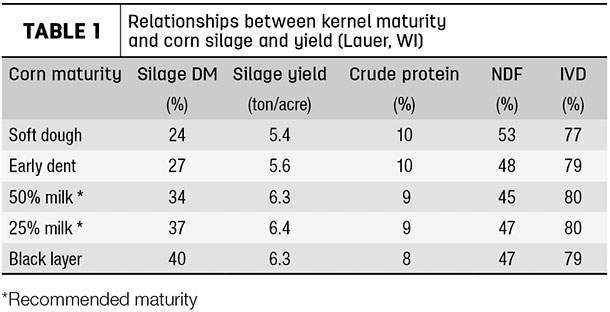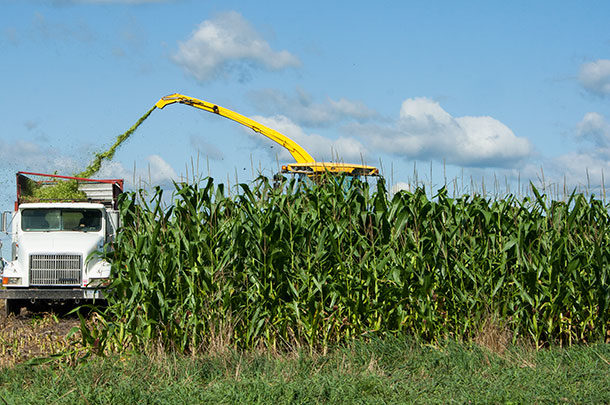Dairy and beef farmers may be facing the need to harvest immature corn silage due to late spring planting due to wet fields and/or prevented plant acreage that allowed farmers to harvest corn silage as silage after Sept. 1.
Potential questions producers may have regarding this scenario are listed to help inform producers on how their decisions could affect yield.
Question: What is the relationship between kernel maturity, yield and quality?
Answer: The University of Wisconsin published data in Table 1. At the soft dough stage, yield will be reduced while crude protein content is higher. The NDF (neutral detergent fiber) levels are over 50% while in vitro digestibility (IVD) is high, reflecting the consistent quality of the corn plant. Sugar and starch contents were not reported. Expect immature corn silage to be higher in sugar and lower in starch. Starch content could increase one percentage point for each one percent drop in NDF. For example, black layer kernel development has reached kernel maturing at 30% starch. Soft dough stage may contain 24% starch (53% NDF for soft dough stage minus 47% NDF for black layer stage could result in 6% lower starch content compared to black layer stage, in this example).

Question: How long should I wait before harvesting immature corn silage?
Answer: If the immature corn plant has not stopped growing (killing frost or drought conditions), wait until the plant dry matter has reached optimal dry matter levels (30% to 36% dry matter). The plant will increase in yield and starch levels. Ensiling immature corn silage can result in excessive seepage reducing nutrient content (soluble protein and sugar or starch) and reduce optimal fermentation. Immature corn silage can vary from 25% to 28% dry matter. If a killing frost occurs, the plant may increase in dry matter by 0.5 percent points per day. If your immature corn silage is 28% dry matter, it may require eight days to achieve 32% dry matter. This guideline depends on daily temperatures, soil moisture, and wind exposure. After the killing frost, the leaves will appear dead, but the stalks are high in moisture content, and the roots can continue to absorb soil moisture. The time needed to reach optimal corn silage stage is 45 days after silking or an additional 750 growing degree-days (GDD).
Question: Should I buy immature corn is it is locally available; how much is it worth?
Answer: Immature corn silage can be a valuable forage, especially if your forage inventory is going to short due to forage inventories on the farm. As Table 1 illustrates, immature corn silage will be a variable forage quality and dry matter. The immature corn silage should be purchased on a dry matter basis; this is critical for both the buyer and seller. The feed value could range from 65% to 85% of the normal corn silage. Adjust the value based on starch and dry matter content. An example is illustrated below:
- Normal corn silage has 30% starch (35% dry matter times 2,000 pounds per ton or 700 pounds of starch) at a price of $40 a ton as fed.
- Immature corn silage has 20% starch (28% dry matter times 2,000 pounds per ton or 560 pounds of starch).
- The immature corn silage is missing 140 pounds of starch per ton.
- Dry corn weighs 56 pounds per bushel and contains 70% starch, resulting in 39 pounds of starch per bushel.
- A total of 3.5 bushels of dry corn equivalent at $4 a bushel reduces the corn silage price by $12 a ton.
- If immature corn silage is $28 a ton ($40 minus $12 for low starch), the value of each pound of dry matter is five cents per pound of dry matter (28% dry matter times 2,000 pounds per ton or 560 pounds of dry matter). Normal corn silage priced at $40 a ton containing 35% dry matter times 2,000 pounds per ton results in 5.7 cents per pound of dry matter.
Question: What other management factors could be considered?
Answer:
- Add a research-based silage inoculant to ensure optimal number of bacteria are present at ensiling, especially if the immature corn silage has frost damage.
- Do not add corn grain, byproduct feed or baled hay to the immature corn silage at ensiling. Adjust the ration after the immature corn silage has been fermented. Adding dry feed ingredients to increase dry matter is a challenge at ensiling time when the forage is variable in dry matter. About 20 pounds of dry feed per ton of immature corn silage is needed to increase dry matter one percentage point.
- Test the immature corn silage for dry matter before harvesting by using a Koster tester or microwave oven on the farm, or send a sample to the commercial testing lab.
- If the corn plant has frost damage, the level of nitrates can increase as the roots absorb soil nitrates while leaf material is not alive to convert the nitrates to nutrients.
- Kernel processing immature corn silage may not be as important with wetter plant material and soft, immature kernels.
- Increasing the length of chop allows for longer forage particle size (similar to grass silage).
- If the immature corn silage does not have an ear, swatting, wilting, then chopping as grass silage can be considered.
- Store the immature corn silage in a separate unit to allow flexibility in feeding to various groups on the farm.
- Plants with no ear or poorly pollinated ears may have a lower yield of one ton of as-fed basis for each one foot in shorter stalk length.
- Frost damage can occur when temperatures remain below 32ºF for a few hours; below 28ºF can kill the plant in a few minutes.

PHOTO: Waiting to harvest until the plant has reached 30% to 36% dry matter will increase yield and starch levels. Photo by Mike Hutjens.

-
Mike Hutjens
- Professor of Animal Sciences Emeritus
- University of Illinois – Urbana










